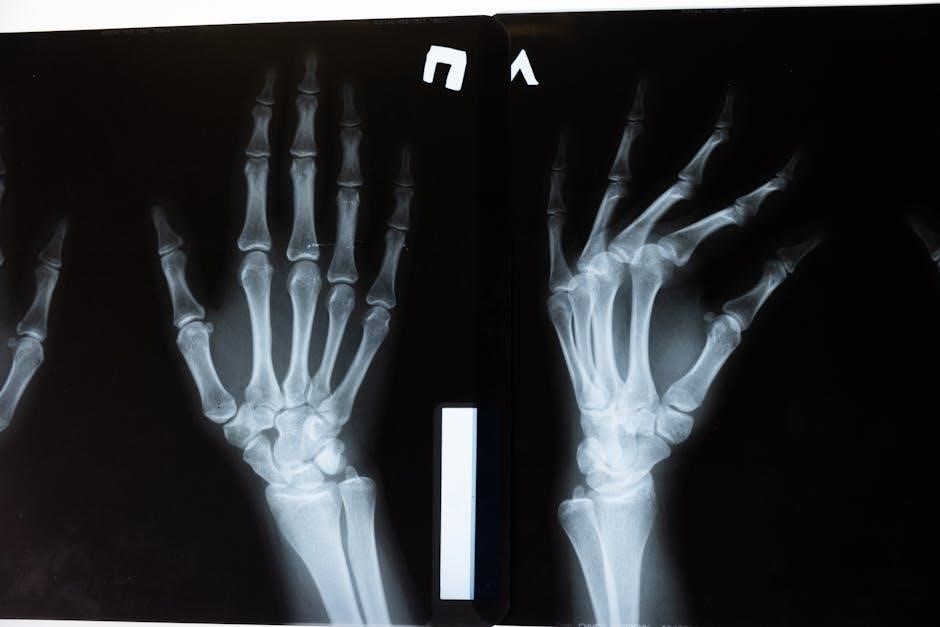radiology ordering guide
A radiology ordering guide is a vital resource for healthcare providers, ensuring appropriate imaging exams are selected for accurate diagnoses and optimal patient outcomes.
Understanding the Importance of a Radiology Ordering Guide
A radiology ordering guide is essential for ensuring that imaging exams are appropriately selected, reducing unnecessary radiation exposure, and improving patient outcomes. It provides healthcare providers with clear criteria for ordering the most suitable tests based on clinical indications, helping to avoid overuse or misuse of imaging services. By adhering to evidence-based guidelines, the guide promotes cost-effective care and enhances the quality of diagnostic decisions. It also serves as a tool for educating providers about the most appropriate imaging modalities for specific conditions, ensuring compliance with medical necessity standards and optimizing the diagnostic process.
Key Concepts in Radiology Ordering
Key concepts in radiology ordering include understanding the appropriate use of imaging modalities, such as X-rays, CT scans, and MRIs, based on clinical guidelines. It involves selecting the most suitable exam for specific indications, ensuring medical necessity, and minimizing radiation exposure. Effective communication between referring physicians and radiologists is crucial to align exam requests with patient needs. Additionally, familiarity with decision-support tools, like ACR Appropriateness Criteria, helps guide ordering decisions. Proper documentation of patient history and symptoms ensures accurate exam selection, while adhering to protocols reduces variability and improves outcomes.

Factors Influencing Radiology Ordering Decisions
Factors influencing radiology ordering decisions include patient history, clinical guidelines, urgency of conditions, and considerations to minimize radiation exposure while ensuring diagnostic accuracy.
Clinical Judgment and Patient History
Clinical judgment and patient history are cornerstone elements in radiology ordering, ensuring exams align with individual needs. A patient’s medical history, symptoms, and prior imaging results guide the selection of appropriate exams, minimizing unnecessary radiation and optimizing diagnostic accuracy. Understanding the patient’s condition helps tailor imaging choices, reducing redundant tests and improving outcomes. Additionally, patient history alerts providers to potential allergies or sensitivities, such as contrast agents, ensuring safety. Accurate and updated patient records are essential for informed decision-making. This personalized approach ensures that radiology orders are both effective and patient-centered, reflecting the unique clinical context of each case.
Role of Imaging Guidelines and Protocols
Imaging guidelines and protocols play a crucial role in standardizing radiology ordering, ensuring evidence-based and consistent decision-making. These guidelines, often developed by professional organizations like the American College of Radiology (ACR), provide recommendations for appropriate imaging exams based on clinical scenarios. They help healthcare providers choose the most suitable test for a patient’s condition, reducing unnecessary scans and radiation exposure. Protocols outline standardized procedures for conducting exams, ensuring consistency and minimizing errors. Adhering to these guidelines promotes high-quality care, legal compliance, and efficient resource use, while also aligning with current medical knowledge and advancements.
Special Considerations for Emergency and Urgent Orders
Emergency and urgent radiology orders require immediate attention to ensure timely patient care. These situations often involve critical conditions, such as trauma or acute symptoms, where rapid imaging is essential for diagnosis. Prioritization of urgent cases is crucial, with clear communication between healthcare providers and radiology teams. Imaging protocols may need to be adapted to balance speed and diagnostic accuracy. Minimizing radiation exposure, especially in sensitive populations, remains a priority. Additionally, emergency orders often require real-time consultation with radiologists to ensure appropriate exam selection and interpretation. Effective communication and streamlined processes are vital to delivering high-quality, time-sensitive care in emergency settings.

Choosing the Right Imaging Exam
Choosing the right imaging exam balances clinical context, patient history, and exam appropriateness to ensure accurate diagnoses. Exams are selected based on symptoms, guidelines, and minimizing radiation exposure for optimal outcomes.
General Principles for Selecting Appropriate Imaging
Selecting the right imaging exam begins with confirming medical necessity, ensuring the exam aligns with clinical guidelines, and prioritizing patient safety. Start with the least invasive option, such as ultrasound, before moving to more complex tests like CT or MRI. Consider factors like radiation exposure, especially for younger patients. Use decision-support tools, such as ACR Appropriateness Criteria, to guide choices. Always review patient history and current symptoms to avoid redundant testing. Consult radiologists when uncertain, as their expertise can refine exam selection. Clear communication of findings ensures timely and accurate diagnoses, optimizing patient care and resource use.
Commonly Ordered Exams and Their Indications
X-rays are commonly used to detect fractures or lung abnormalities, while CT scans provide detailed images of internal injuries or abnormalities. MRI is ideal for evaluating soft tissue, joints, or neurological conditions. Ultrasound is preferred for assessing abdominal organs, gallbladder issues, or fetal development. Each exam is selected based on its ability to provide clear diagnostic information. For example, chest X-rays are routine for respiratory issues, while MRIs are chosen for detailed brain or spinal cord imaging. Understanding the strengths of each modality ensures appropriate use, improving diagnostic accuracy and patient outcomes. This tailored approach minimizes unnecessary testing and optimizes care.

Tools and Resources for Radiology Ordering
Clinical Decision Support (CDS) systems, ACR Appropriateness Criteria, and decision-support tools guide providers in selecting appropriate imaging exams, ensuring compliance with evidence-based guidelines and reducing unnecessary testing.
Clinical Decision Support (CDS) Systems
Clinical Decision Support (CDS) systems are electronic tools that assist healthcare providers in ordering appropriate radiology exams. These systems use evidence-based guidelines to recommend the most suitable imaging modalities for specific clinical scenarios. By integrating with electronic health records (EHRs), CDS systems can analyze patient data, such as medical history and symptoms, to provide real-time recommendations. This helps reduce unnecessary radiation exposure and ensures that exams are medically necessary. Additionally, CDS systems can alert providers to potential contraindications or alternative tests, improving patient safety and diagnostic accuracy. Regular updates ensure that recommendations align with the latest medical research and protocols, making CDS systems invaluable in modern healthcare settings.
ACR Appropriateness Criteria and Other Guidelines
The American College of Radiology (ACR) Appropriateness Criteria provide evidence-based guidelines for selecting the most appropriate imaging exams for specific clinical conditions. These criteria rank imaging modalities based on their effectiveness, safety, and cost-efficiency, helping healthcare providers make informed decisions. By adhering to these guidelines, unnecessary exams and radiation exposure can be minimized. Other complementary guidelines, such as those from the American College of Emergency Physicians (ACEP) or the National Institute for Health and Care Excellence (NICE), further support radiology ordering. Together, these resources ensure that imaging orders align with best practices, improving patient outcomes and reducing healthcare costs.
Decision-Support Tools for Radiology Orders
Decision-support tools, such as Clinical Decision Support (CDS) systems, play a crucial role in radiology ordering by providing healthcare providers with evidence-based recommendations. These tools analyze patient data, symptoms, and clinical guidelines to suggest the most appropriate imaging exams. By integrating with electronic health records (EHRs), they ensure orders align with medical necessity and reduce unnecessary radiation exposure. Many systems incorporate the ACR Appropriateness Criteria, ensuring compliance with established guidelines. Advanced tools may also leverage artificial intelligence to enhance accuracy and efficiency. Regular updates keep these systems aligned with the latest research and best practices, making them indispensable for modern radiology ordering workflows.
Consulting with Radiologists
Consulting with radiologists is a critical step in the radiology ordering process, ensuring exams are appropriate and aligned with clinical needs. Radiologists can provide valuable insights into selecting the most suitable imaging modality, reducing unnecessary tests, and optimizing diagnostic accuracy. This collaboration helps clarify clinical questions, interpret complex cases, and tailor exams to patient-specific conditions. Many institutions encourage direct communication between ordering providers and radiologists to address uncertainties or special requirements. Additionally, radiologists often offer guidance on patient preparation, positioning, and contrast use, enhancing exam quality and patient safety. This collaborative approach fosters better decision-making and improves overall patient care outcomes.

Troubleshooting Common Ordering Issues
Addressing discrepancies between ordered and performed exams is crucial for patient safety. Reducing unnecessary radiation exposure and ensuring accurate imaging are key challenges in radiology ordering.

Handling Discrepancies Between Ordered and Performed Exams
Discrepancies between ordered and performed exams can arise due to miscommunication or system errors. Ensuring clear communication between providers and radiologists is essential to resolve such issues promptly. Reviewing the order and performed exam details helps identify mismatches. If a discrepancy is found, immediate clarification is necessary to avoid delayed diagnoses or inappropriate care. Using electronic health records (EHRs) and clinical decision support (CDS) systems can minimize errors. Radiologists should be consulted to verify the appropriateness of the performed exam. Patient safety and accurate outcomes depend on resolving these discrepancies efficiently, ensuring the correct imaging is conducted as per the clinical scenario.
Reducing Unnecessary Radiation Exposure
Minimizing radiation exposure is critical, especially for sensitive populations like children and pregnant women. Choosing the least invasive imaging modalities, such as ultrasound or MRI, when appropriate, can significantly reduce radiation risk. Providers should adhere to guidelines like the Image Gently campaign for pediatric imaging; Regular review of patient history and prior imaging helps avoid redundant exams. The use of clinical decision support systems ensures ordering of exams with justified radiation exposure. Radiologists play a key role in monitoring and optimizing radiation doses. Open communication between providers and radiologists further enhances safe practices, ensuring patient safety while maintaining diagnostic accuracy.
![]()
Legal and Ethical Considerations
Ensuring medical necessity and informed consent are paramount. Providers must balance diagnostic benefits with patient risks, adhering to ethical standards and protecting sensitive patient information.
Ensuring Medical Necessity
Medical necessity is a cornerstone of ethical radiology ordering, ensuring that imaging exams are justified by clinical evidence. Providers must document patients’ symptoms, medical history, and specific indications to validate the need for each test. This approach minimizes unnecessary radiation exposure and reduces healthcare costs. Adherence to evidence-based guidelines, such as the ACR Appropriateness Criteria, helps confirm that exams are appropriate and aligned with patient needs. Regular audits and feedback mechanisms further ensure compliance with medical necessity standards, promoting high-quality patient care while maintaining legal and ethical responsibilities in radiology practice.
Addressing Informed Consent
Informed consent is a critical aspect of radiology ordering, ensuring patients are fully aware of the procedure’s risks, benefits, and alternatives. Providers must discuss the nature of the imaging exam, potential side effects, and any necessary precautions. Patients should understand why the exam is recommended and how it will aid in their diagnosis or treatment. This process respects patient autonomy and fosters trust in the healthcare provider-patient relationship. Specific attention must be paid to risks like radiation exposure, particularly for vulnerable populations such as pregnant women. Clear communication and documentation of consent are essential for accountability and transparency in radiology care.

Patient Preparation and Communication
Effective patient preparation and communication are essential for successful radiology exams. Clear instructions ensure patients understand procedures, reducing anxiety and improving outcomes. Proper preparation includes specific guidelines like fasting or removing jewelry, tailored to the exam type. Open communication builds trust and ensures patients are informed about their care.
Pre-Procedure Instructions for Patients
Clear pre-procedure instructions are crucial for patient safety and exam accuracy. Patients should be informed about specific requirements, such as fasting, removing jewelry, or preparing for a full bladder. For MRI scans, patients must avoid carrying metal objects and disclose any implants or allergies. Providing written guidelines ensures compliance and reduces anxiety. Instructions should also address medication management and the importance of arriving early for registration. Communication must be tailored to the exam type, ensuring patients understand their role in achieving optimal results. Proper preparation enhances the quality of radiology exams and ensures patient comfort throughout the process.
Importance of Patient History and Medication Information
Patient history and medication information are critical for safe and effective radiology ordering. A detailed medical history helps identify allergies, prior surgeries, or conditions that may influence exam selection or contraindications. Medication lists are essential to avoid interactions or complications during procedures. For example, certain medications may require withholding before imaging or affect contrast agent safety. Accurate patient history also ensures appropriate exam selection, reducing unnecessary radiation exposure. By gathering comprehensive information, healthcare providers can tailor imaging decisions to individual needs, improving diagnostic accuracy and patient safety. This step is vital for avoiding errors and ensuring optimal outcomes. Clear communication of this data is essential for all team members involved.

Future Trends in Radiology Ordering
Future trends include AI integration for smarter decision-making, seamless EHR integration, and advanced decision-support tools, enhancing efficiency and accuracy in radiology ordering processes.

Role of Artificial Intelligence
Artificial intelligence (AI) is revolutionizing radiology ordering by enhancing decision-making and streamlining workflows. AI algorithms analyze patient data, medical histories, and imaging guidelines to recommend appropriate exams, reducing errors and unnecessary tests. Machine learning models can predict diagnostic outcomes, helping clinicians make informed decisions faster. AI also automates routine tasks, such as order entry and protocol selection, freeing up time for more complex cases. Additionally, AI-powered tools improve image interpretation accuracy and facilitate communication between radiologists and referring physicians. As AI integration deepens, it promises to optimize resource allocation, reduce costs, and improve patient care outcomes in radiology. Ethical considerations and data privacy remain key focus areas.
Integration with Electronic Health Records (EHRs)
Integration of radiology ordering with Electronic Health Records (EHRs) streamlines clinical workflows, enhancing efficiency and accuracy. EHRs provide radiologists and ordering physicians with real-time access to patient histories, lab results, and prior imaging, enabling informed decision-making. Automated order entry reduces errors and duplication, ensuring exams align with clinical needs. EHRs also facilitate seamless communication between healthcare providers, improving coordination. Additionally, integration supports compliance with imaging guidelines, such as ACR Appropriateness Criteria, by embedding decision-support tools directly into workflows. This connectivity enhances patient care, reduces delays, and minimizes redundant testing, making EHR integration a cornerstone of modern radiology ordering systems.